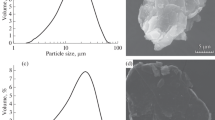Abstract
EXPERIMENTS, to be described elsewhere, in which the electromotive force generated by a loaded rotating steel ball in frictional contact with a metal block was measured, showed that the steel ball tended to pick up metal from the flat surface, and that metallic films wiped out on metal surfaces by hand affected both the magnitude of the electromotive force and the size of the final wear impression. Films of tin, copper, lead and zinc wiped out on Timken test blocks reduced the electromotive force in this order of merit when no oil had been applied to the contact. On the other hand, a film of tin rubbed on to the flat surface of a hardened steel roller led to an increase in both the electromotive force and the diameter of the final wear impression, and a film of lead rubbed on to a block of copper had a similar effect.
Similar content being viewed by others
References
Heaton, J. L., Bristow, J. R., Whittingham, G., and Hughes, T. P., NATURE, 150, 520 (1942).
Bowden, F. P., and Tabor, D., NATURE, 15O, 197 (1942).
Author information
Authors and Affiliations
Rights and permissions
About this article
Cite this article
SCHNURMANN, R. Frictional Properties of Metallic Films. Nature 151, 420–421 (1943). https://doi.org/10.1038/151420b0
Issue Date:
DOI: https://doi.org/10.1038/151420b0
- Springer Nature Limited
This article is cited by
-
Rate of Wear in the Region of the Validity of Amontons' Law
Nature (1948)
-
Frictronal Properties of Metallic Films
Nature (1943)
-
Letter to Editors
Nature (1943)
-
Frictional Properties of Metallic Films
Nature (1943)





